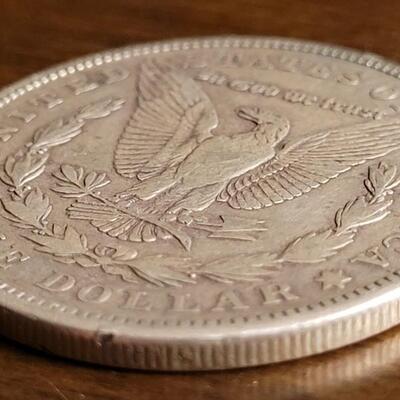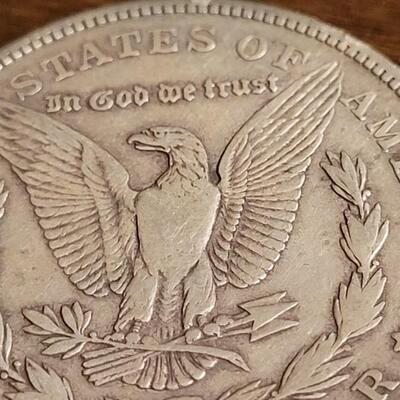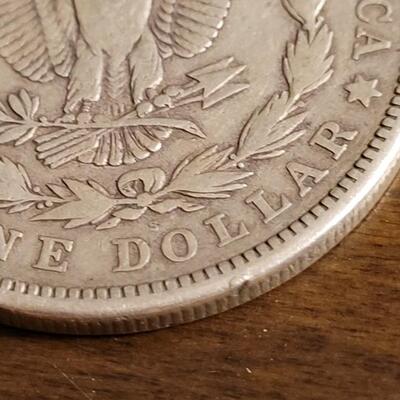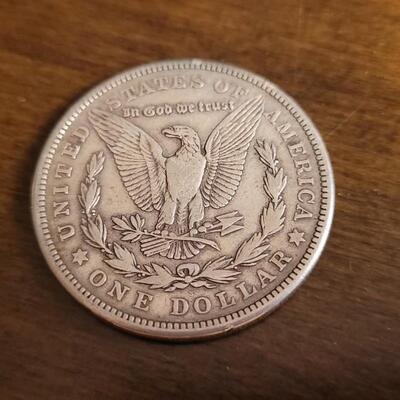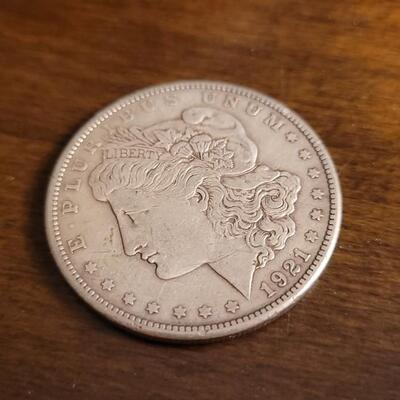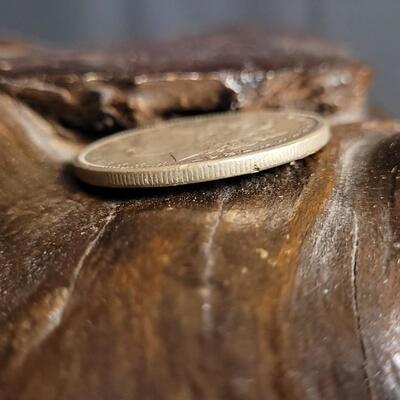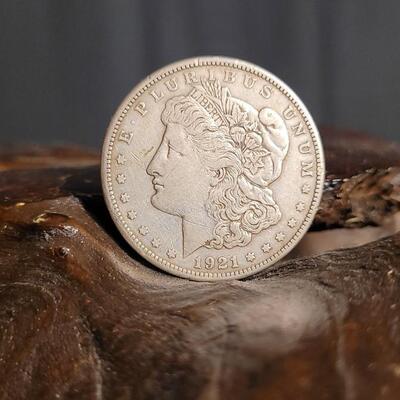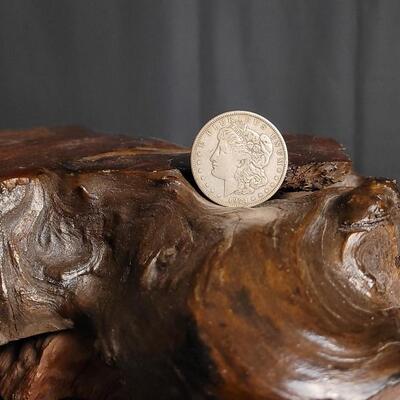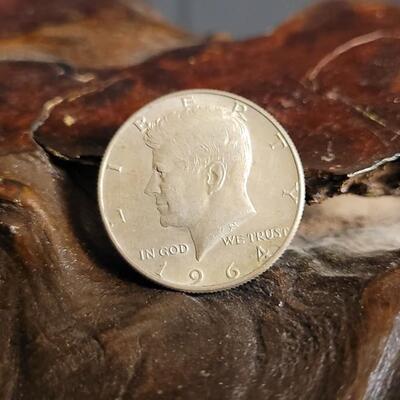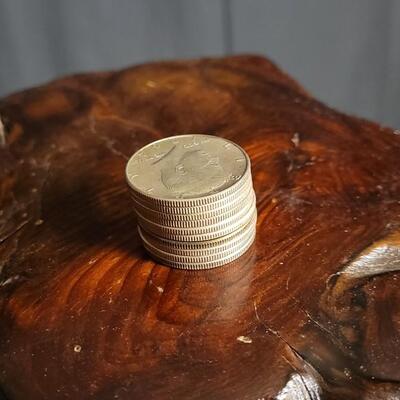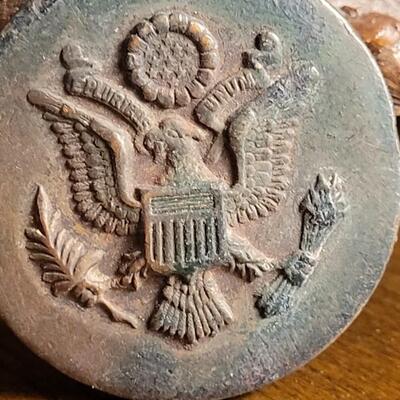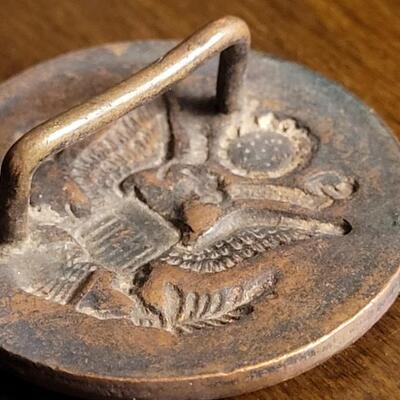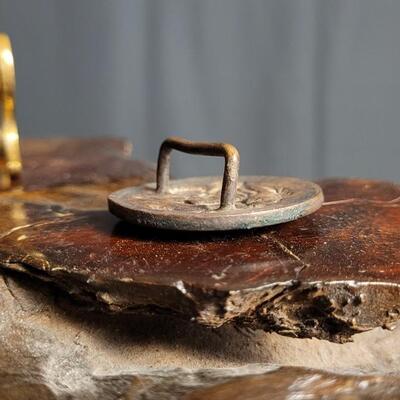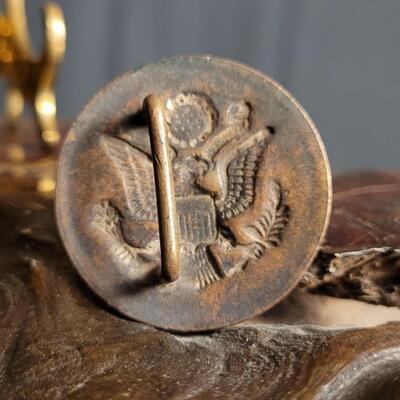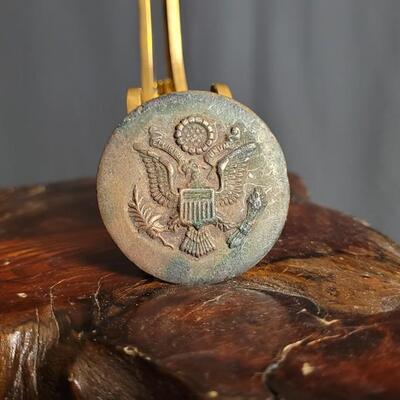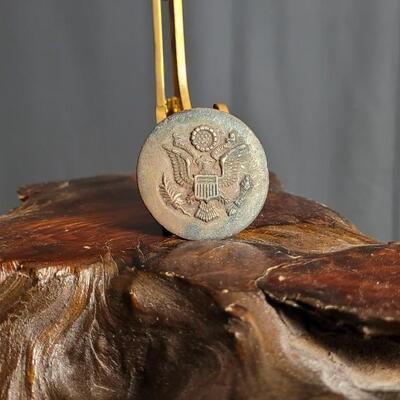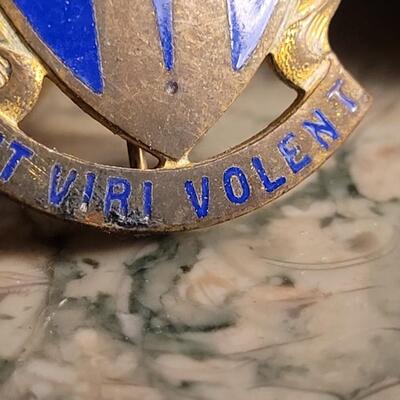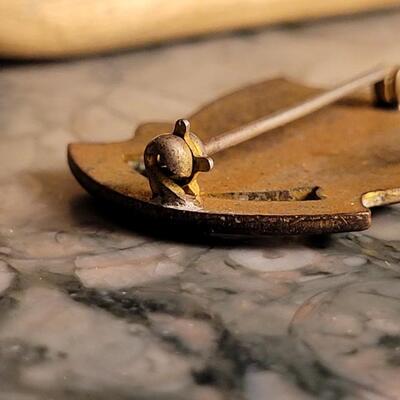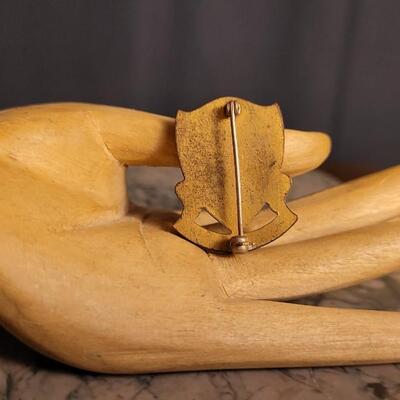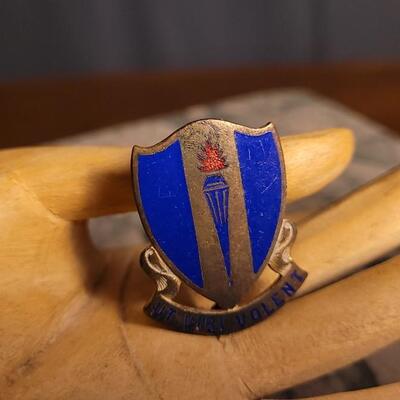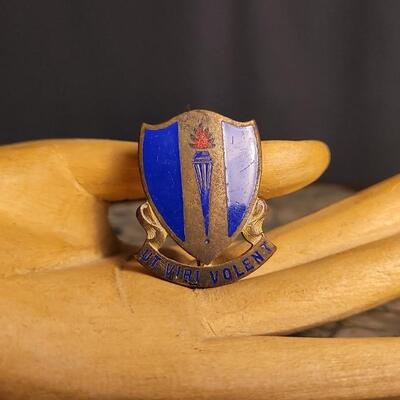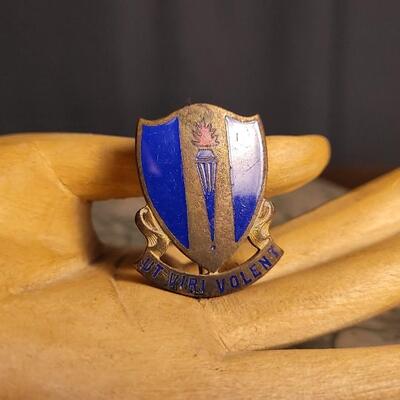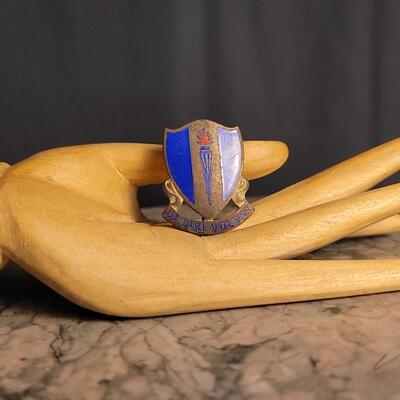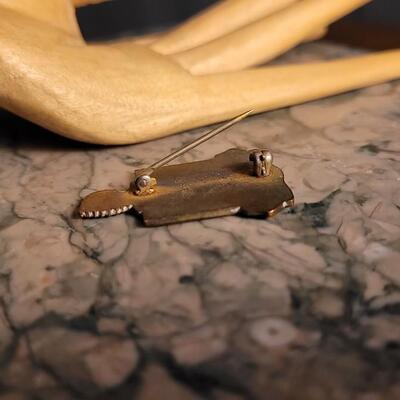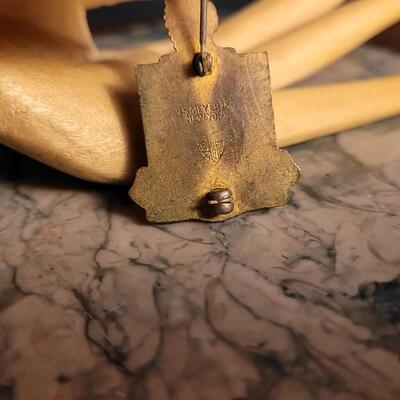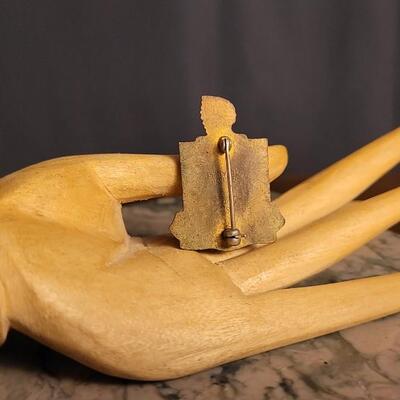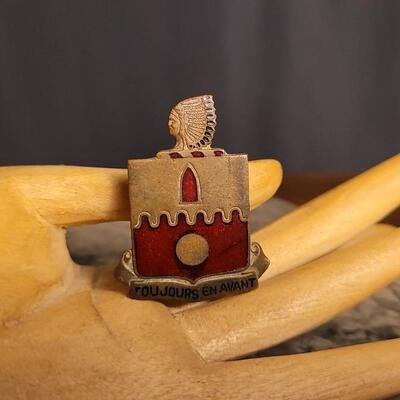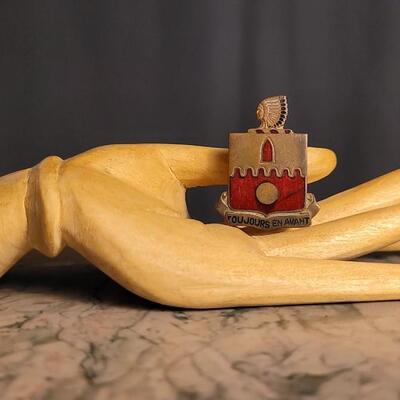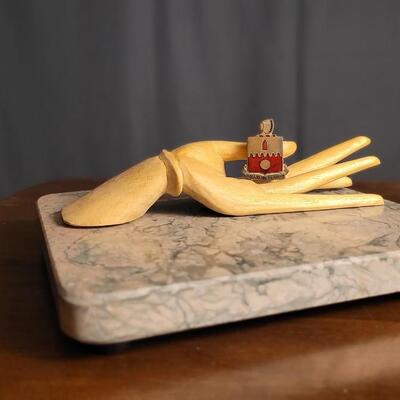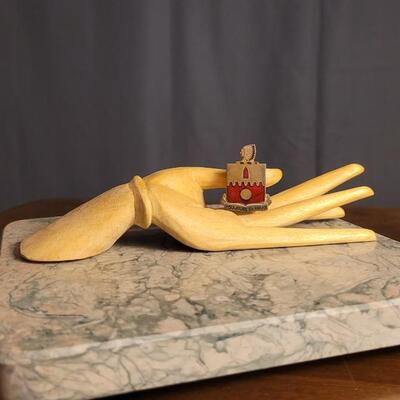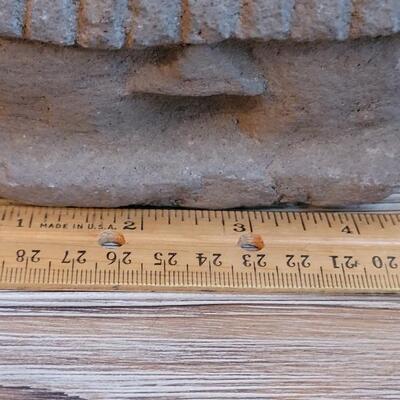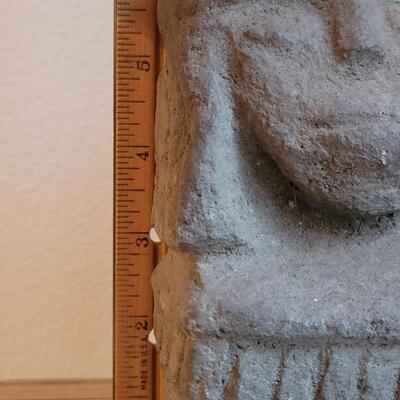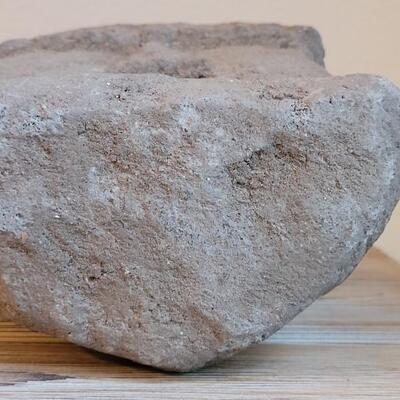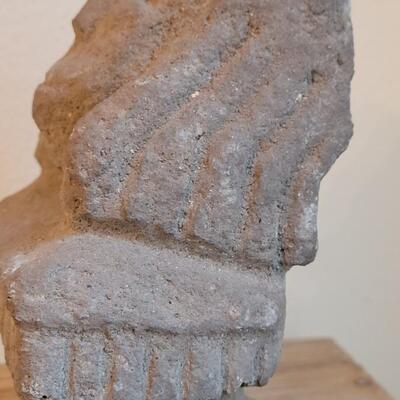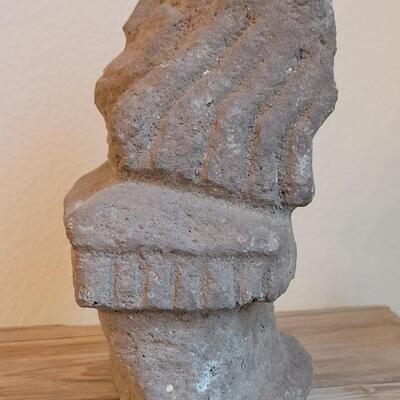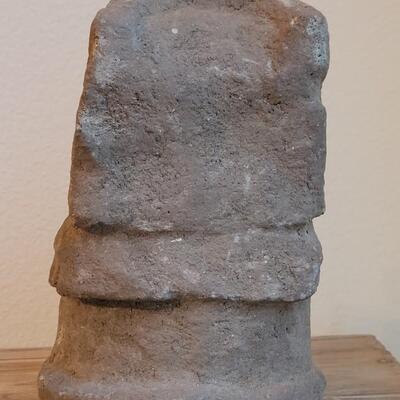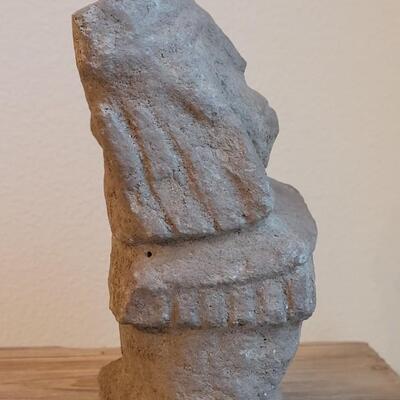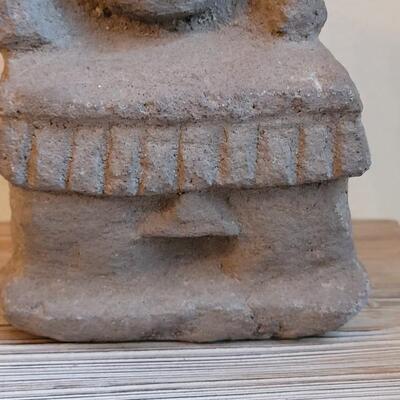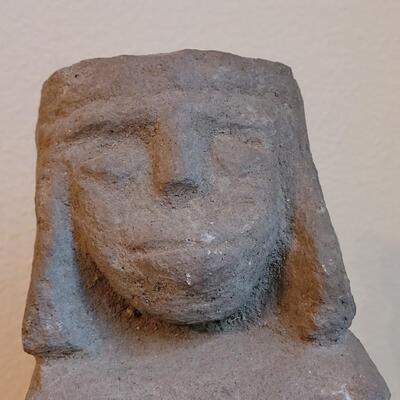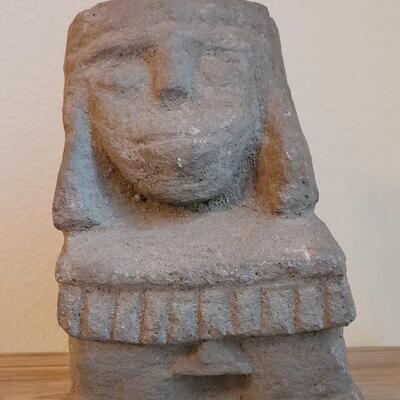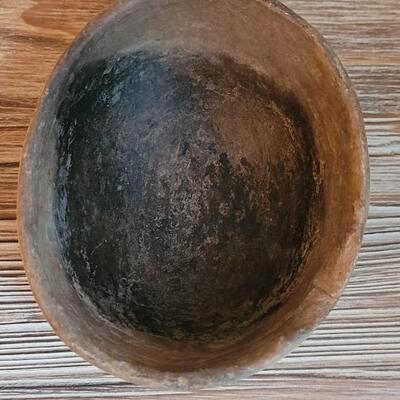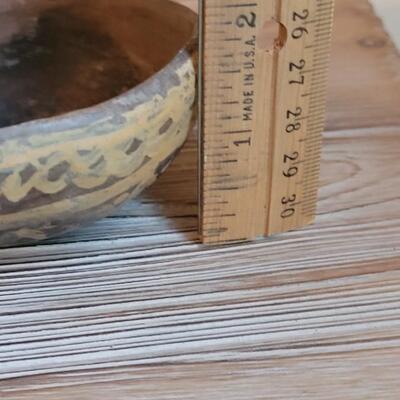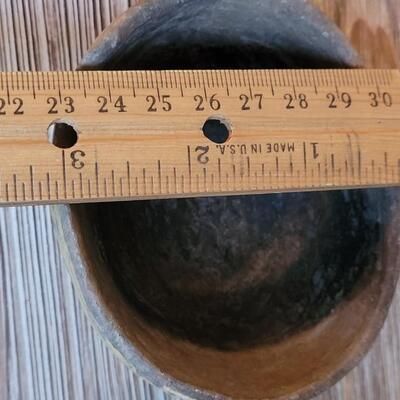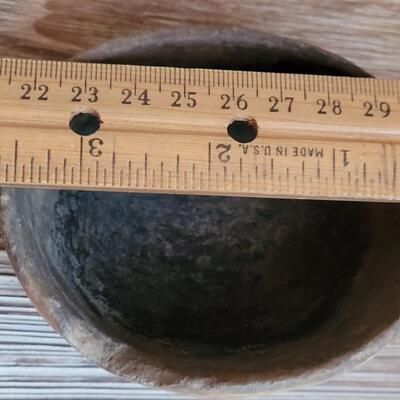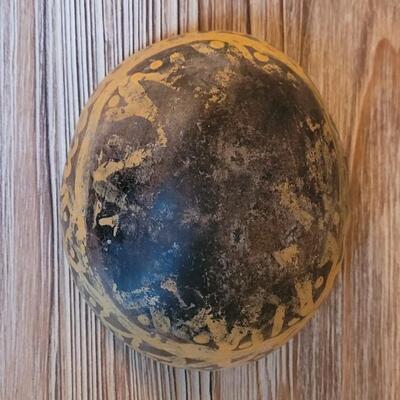-
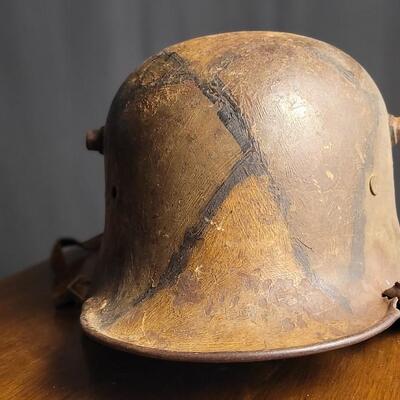
This Antique Relic of war is a Very Rare handpainted camouflage soldier's helmet. In impressive condition for age, it retains the original leather chin strap and the interior leather head Webbing. The colors are true to the patterns and shades their Army was allowed to use down to the finger-wide black lines. A true collector's piece. These first modern M16 helmets evolved into the M18 helmets by the end of WWI. The M16 and M18 helmets remained in usage through-out the Weimar Reichswehr era and on into the early years of the Third Reich until the development of the smaller, lighter M35 style helmet in June 1935. Of Note: In July 1918 Chief of the General Staff of the Field Army, Erich Ludendorff issued a directive which clearly laid out the camouflage colors and pattern that was to be applied to all helmets in the field. The directive also included the amounts of paint that 1,000 helmets would require as five kilograms, (11Lbs), each of, green, ochre yellow and rust brown, and two kilograms, (4.4 Lbs), of black paint. 2001 / 2244 sold -
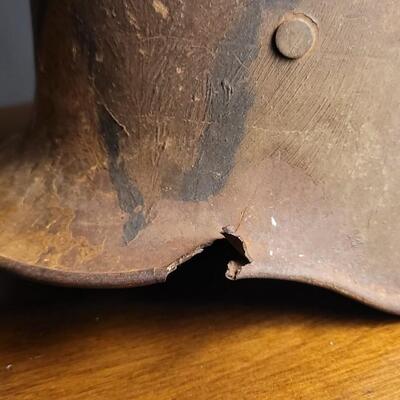
This Antique Relic of war is a Very Rare handpainted camouflage soldier's helmet. In impressive condition for age, it retains the original leather chin strap and the interior leather head Webbing. The colors are true to the patterns and shades their Army was allowed to use down to the finger-wide black lines. A true collector's piece. These first modern M16 helmets evolved into the M18 helmets by the end of WWI. The M16 and M18 helmets remained in usage through-out the Weimar Reichswehr era and on into the early years of the Third Reich until the development of the smaller, lighter M35 style helmet in June 1935. Of Note: In July 1918 Chief of the General Staff of the Field Army, Erich Ludendorff issued a directive which clearly laid out the camouflage colors and pattern that was to be applied to all helmets in the field. The directive also included the amounts of paint that 1,000 helmets would require as five kilograms, (11Lbs), each of, green, ochre yellow and rust brown, and two kilograms, (4.4 Lbs), of black paint. 2002 / 2244 sold -
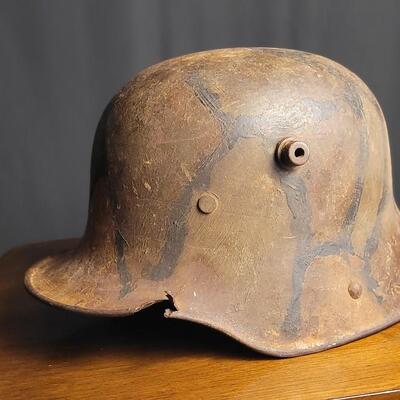
This Antique Relic of war is a Very Rare handpainted camouflage soldier's helmet. In impressive condition for age, it retains the original leather chin strap and the interior leather head Webbing. The colors are true to the patterns and shades their Army was allowed to use down to the finger-wide black lines. A true collector's piece. These first modern M16 helmets evolved into the M18 helmets by the end of WWI. The M16 and M18 helmets remained in usage through-out the Weimar Reichswehr era and on into the early years of the Third Reich until the development of the smaller, lighter M35 style helmet in June 1935. Of Note: In July 1918 Chief of the General Staff of the Field Army, Erich Ludendorff issued a directive which clearly laid out the camouflage colors and pattern that was to be applied to all helmets in the field. The directive also included the amounts of paint that 1,000 helmets would require as five kilograms, (11Lbs), each of, green, ochre yellow and rust brown, and two kilograms, (4.4 Lbs), of black paint. 2003 / 2244 sold -
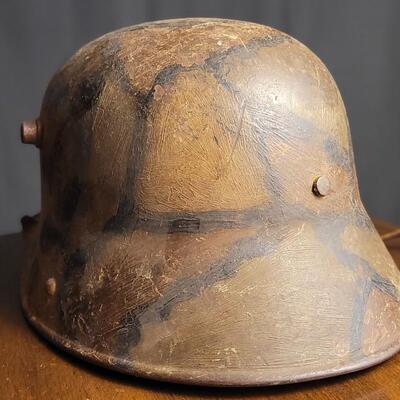
This Antique Relic of war is a Very Rare handpainted camouflage soldier's helmet. In impressive condition for age, it retains the original leather chin strap and the interior leather head Webbing. The colors are true to the patterns and shades their Army was allowed to use down to the finger-wide black lines. A true collector's piece. These first modern M16 helmets evolved into the M18 helmets by the end of WWI. The M16 and M18 helmets remained in usage through-out the Weimar Reichswehr era and on into the early years of the Third Reich until the development of the smaller, lighter M35 style helmet in June 1935. Of Note: In July 1918 Chief of the General Staff of the Field Army, Erich Ludendorff issued a directive which clearly laid out the camouflage colors and pattern that was to be applied to all helmets in the field. The directive also included the amounts of paint that 1,000 helmets would require as five kilograms, (11Lbs), each of, green, ochre yellow and rust brown, and two kilograms, (4.4 Lbs), of black paint. 2004 / 2244 sold -
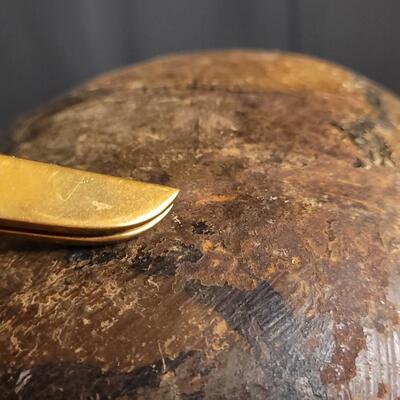
This Antique Relic of war is a Very Rare handpainted camouflage soldier's helmet. In impressive condition for age, it retains the original leather chin strap and the interior leather head Webbing. The colors are true to the patterns and shades their Army was allowed to use down to the finger-wide black lines. A true collector's piece. These first modern M16 helmets evolved into the M18 helmets by the end of WWI. The M16 and M18 helmets remained in usage through-out the Weimar Reichswehr era and on into the early years of the Third Reich until the development of the smaller, lighter M35 style helmet in June 1935. Of Note: In July 1918 Chief of the General Staff of the Field Army, Erich Ludendorff issued a directive which clearly laid out the camouflage colors and pattern that was to be applied to all helmets in the field. The directive also included the amounts of paint that 1,000 helmets would require as five kilograms, (11Lbs), each of, green, ochre yellow and rust brown, and two kilograms, (4.4 Lbs), of black paint. 2005 / 2244 sold -
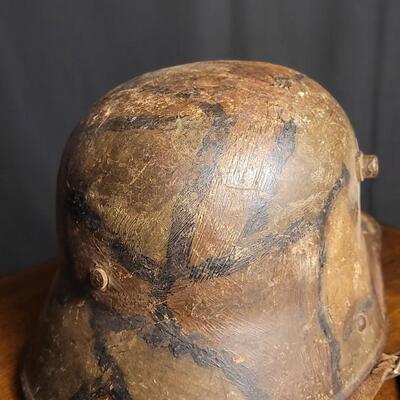
This Antique Relic of war is a Very Rare handpainted camouflage soldier's helmet. In impressive condition for age, it retains the original leather chin strap and the interior leather head Webbing. The colors are true to the patterns and shades their Army was allowed to use down to the finger-wide black lines. A true collector's piece. These first modern M16 helmets evolved into the M18 helmets by the end of WWI. The M16 and M18 helmets remained in usage through-out the Weimar Reichswehr era and on into the early years of the Third Reich until the development of the smaller, lighter M35 style helmet in June 1935. Of Note: In July 1918 Chief of the General Staff of the Field Army, Erich Ludendorff issued a directive which clearly laid out the camouflage colors and pattern that was to be applied to all helmets in the field. The directive also included the amounts of paint that 1,000 helmets would require as five kilograms, (11Lbs), each of, green, ochre yellow and rust brown, and two kilograms, (4.4 Lbs), of black paint. 2006 / 2244 sold -
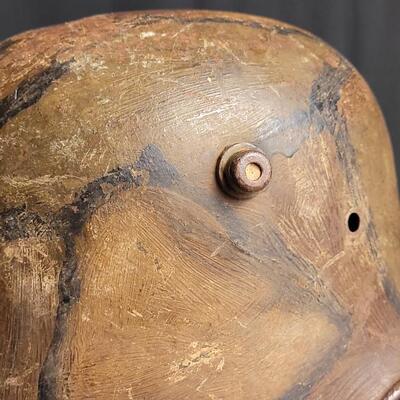
This Antique Relic of war is a Very Rare handpainted camouflage soldier's helmet. In impressive condition for age, it retains the original leather chin strap and the interior leather head Webbing. The colors are true to the patterns and shades their Army was allowed to use down to the finger-wide black lines. A true collector's piece. These first modern M16 helmets evolved into the M18 helmets by the end of WWI. The M16 and M18 helmets remained in usage through-out the Weimar Reichswehr era and on into the early years of the Third Reich until the development of the smaller, lighter M35 style helmet in June 1935. Of Note: In July 1918 Chief of the General Staff of the Field Army, Erich Ludendorff issued a directive which clearly laid out the camouflage colors and pattern that was to be applied to all helmets in the field. The directive also included the amounts of paint that 1,000 helmets would require as five kilograms, (11Lbs), each of, green, ochre yellow and rust brown, and two kilograms, (4.4 Lbs), of black paint. 2007 / 2244 sold -
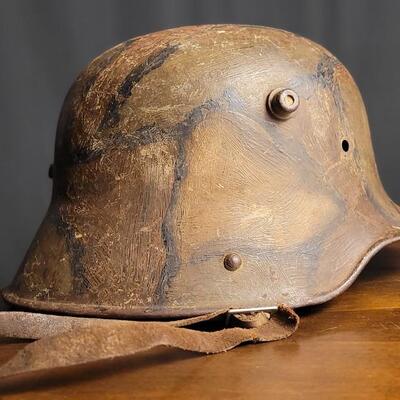
This Antique Relic of war is a Very Rare handpainted camouflage soldier's helmet. In impressive condition for age, it retains the original leather chin strap and the interior leather head Webbing. The colors are true to the patterns and shades their Army was allowed to use down to the finger-wide black lines. A true collector's piece. These first modern M16 helmets evolved into the M18 helmets by the end of WWI. The M16 and M18 helmets remained in usage through-out the Weimar Reichswehr era and on into the early years of the Third Reich until the development of the smaller, lighter M35 style helmet in June 1935. Of Note: In July 1918 Chief of the General Staff of the Field Army, Erich Ludendorff issued a directive which clearly laid out the camouflage colors and pattern that was to be applied to all helmets in the field. The directive also included the amounts of paint that 1,000 helmets would require as five kilograms, (11Lbs), each of, green, ochre yellow and rust brown, and two kilograms, (4.4 Lbs), of black paint. 2008 / 2244 sold -
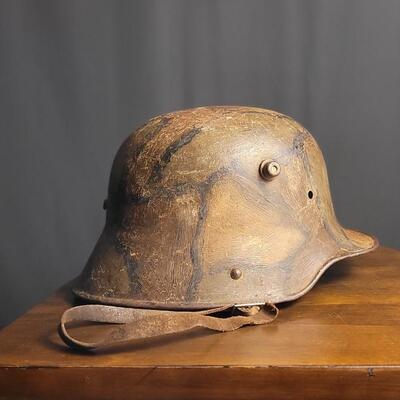
This Antique Relic of war is a Very Rare handpainted camouflage soldier's helmet. In impressive condition for age, it retains the original leather chin strap and the interior leather head Webbing. The colors are true to the patterns and shades their Army was allowed to use down to the finger-wide black lines. A true collector's piece. These first modern M16 helmets evolved into the M18 helmets by the end of WWI. The M16 and M18 helmets remained in usage through-out the Weimar Reichswehr era and on into the early years of the Third Reich until the development of the smaller, lighter M35 style helmet in June 1935. Of Note: In July 1918 Chief of the General Staff of the Field Army, Erich Ludendorff issued a directive which clearly laid out the camouflage colors and pattern that was to be applied to all helmets in the field. The directive also included the amounts of paint that 1,000 helmets would require as five kilograms, (11Lbs), each of, green, ochre yellow and rust brown, and two kilograms, (4.4 Lbs), of black paint. 2009 / 2244 sold -
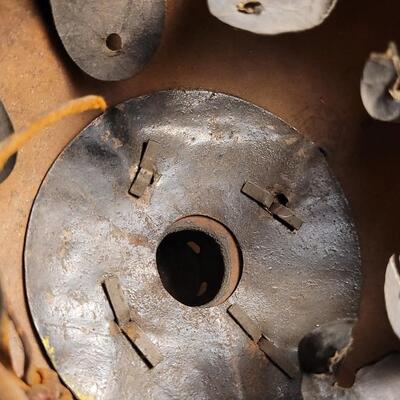
☆ Missing the top point. THE GERMAN ARMY’S spiked helmet or pickelhaube (is arguably one of the most enduring symbols of the First World War. The polished black leather helmet with ornamental metal spike on top did very little to protect the wearer from bullets or shell fragments, but it was instantly recognizable by friend and foe alike. And while the pickelhaube will forever be linked to the armies of Kaiser Wilhelm II, the distinctive piece of headgear was enormously popular with a number of nations’ armies during the 19th Century. 2010 / 2244 -
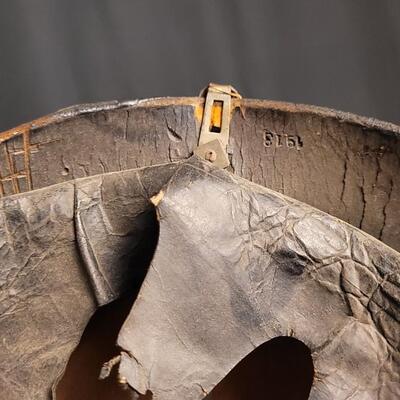
☆ Missing the top point. THE GERMAN ARMY’S spiked helmet or pickelhaube (is arguably one of the most enduring symbols of the First World War. The polished black leather helmet with ornamental metal spike on top did very little to protect the wearer from bullets or shell fragments, but it was instantly recognizable by friend and foe alike. And while the pickelhaube will forever be linked to the armies of Kaiser Wilhelm II, the distinctive piece of headgear was enormously popular with a number of nations’ armies during the 19th Century. 2011 / 2244 -
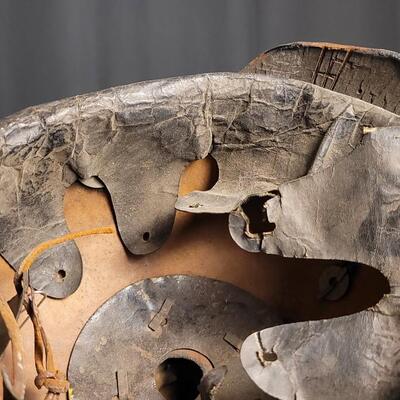
☆ Missing the top point. THE GERMAN ARMY’S spiked helmet or pickelhaube (is arguably one of the most enduring symbols of the First World War. The polished black leather helmet with ornamental metal spike on top did very little to protect the wearer from bullets or shell fragments, but it was instantly recognizable by friend and foe alike. And while the pickelhaube will forever be linked to the armies of Kaiser Wilhelm II, the distinctive piece of headgear was enormously popular with a number of nations’ armies during the 19th Century. 2012 / 2244 -
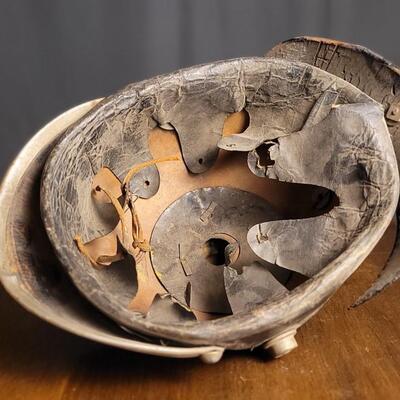
☆ Missing the top point. THE GERMAN ARMY’S spiked helmet or pickelhaube (is arguably one of the most enduring symbols of the First World War. The polished black leather helmet with ornamental metal spike on top did very little to protect the wearer from bullets or shell fragments, but it was instantly recognizable by friend and foe alike. And while the pickelhaube will forever be linked to the armies of Kaiser Wilhelm II, the distinctive piece of headgear was enormously popular with a number of nations’ armies during the 19th Century. 2013 / 2244 -
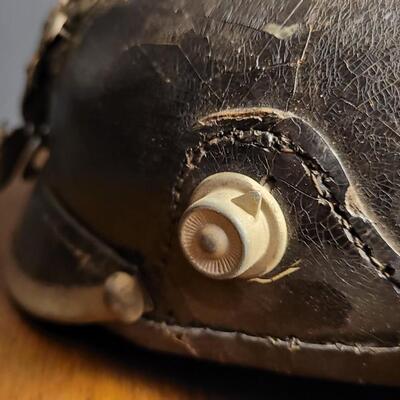
☆ Missing the top point. THE GERMAN ARMY’S spiked helmet or pickelhaube (is arguably one of the most enduring symbols of the First World War. The polished black leather helmet with ornamental metal spike on top did very little to protect the wearer from bullets or shell fragments, but it was instantly recognizable by friend and foe alike. And while the pickelhaube will forever be linked to the armies of Kaiser Wilhelm II, the distinctive piece of headgear was enormously popular with a number of nations’ armies during the 19th Century. 2014 / 2244 -
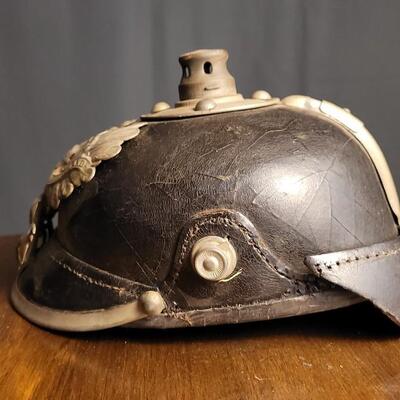
☆ Missing the top point. THE GERMAN ARMY’S spiked helmet or pickelhaube (is arguably one of the most enduring symbols of the First World War. The polished black leather helmet with ornamental metal spike on top did very little to protect the wearer from bullets or shell fragments, but it was instantly recognizable by friend and foe alike. And while the pickelhaube will forever be linked to the armies of Kaiser Wilhelm II, the distinctive piece of headgear was enormously popular with a number of nations’ armies during the 19th Century. 2015 / 2244 -
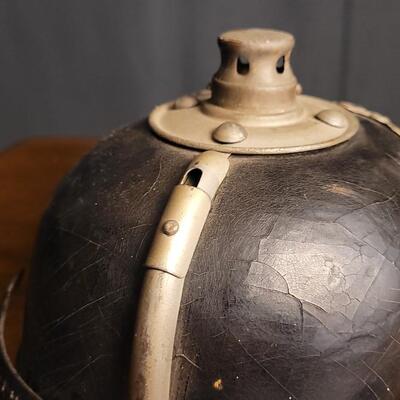
☆ Missing the top point. THE GERMAN ARMY’S spiked helmet or pickelhaube (is arguably one of the most enduring symbols of the First World War. The polished black leather helmet with ornamental metal spike on top did very little to protect the wearer from bullets or shell fragments, but it was instantly recognizable by friend and foe alike. And while the pickelhaube will forever be linked to the armies of Kaiser Wilhelm II, the distinctive piece of headgear was enormously popular with a number of nations’ armies during the 19th Century. 2016 / 2244 -
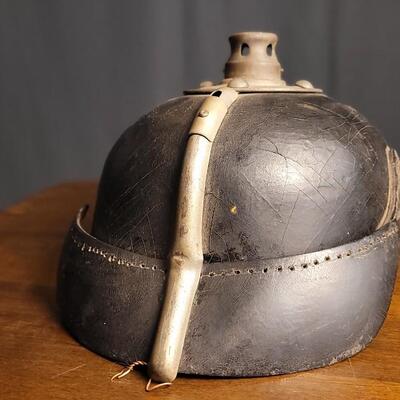
☆ Missing the top point. THE GERMAN ARMY’S spiked helmet or pickelhaube (is arguably one of the most enduring symbols of the First World War. The polished black leather helmet with ornamental metal spike on top did very little to protect the wearer from bullets or shell fragments, but it was instantly recognizable by friend and foe alike. And while the pickelhaube will forever be linked to the armies of Kaiser Wilhelm II, the distinctive piece of headgear was enormously popular with a number of nations’ armies during the 19th Century. 2017 / 2244 -
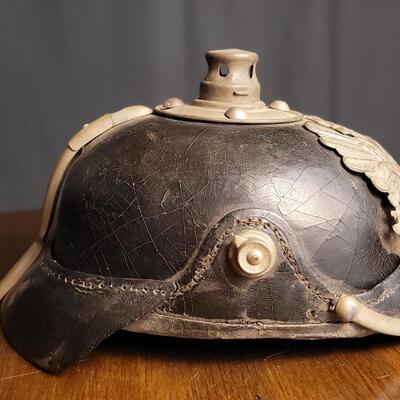
☆ Missing the top point. THE GERMAN ARMY’S spiked helmet or pickelhaube (is arguably one of the most enduring symbols of the First World War. The polished black leather helmet with ornamental metal spike on top did very little to protect the wearer from bullets or shell fragments, but it was instantly recognizable by friend and foe alike. And while the pickelhaube will forever be linked to the armies of Kaiser Wilhelm II, the distinctive piece of headgear was enormously popular with a number of nations’ armies during the 19th Century. 2018 / 2244 -
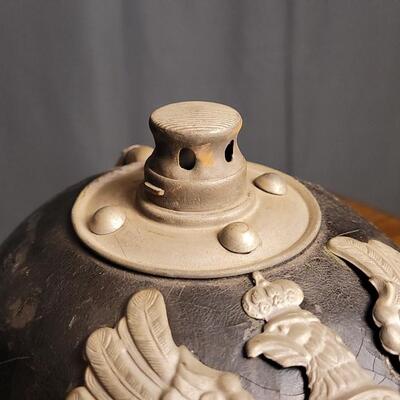
☆ Missing the top point. THE GERMAN ARMY’S spiked helmet or pickelhaube (is arguably one of the most enduring symbols of the First World War. The polished black leather helmet with ornamental metal spike on top did very little to protect the wearer from bullets or shell fragments, but it was instantly recognizable by friend and foe alike. And while the pickelhaube will forever be linked to the armies of Kaiser Wilhelm II, the distinctive piece of headgear was enormously popular with a number of nations’ armies during the 19th Century. 2019 / 2244 -
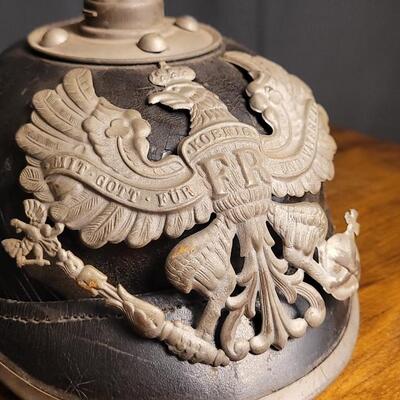
☆ Missing the top point. THE GERMAN ARMY’S spiked helmet or pickelhaube (is arguably one of the most enduring symbols of the First World War. The polished black leather helmet with ornamental metal spike on top did very little to protect the wearer from bullets or shell fragments, but it was instantly recognizable by friend and foe alike. And while the pickelhaube will forever be linked to the armies of Kaiser Wilhelm II, the distinctive piece of headgear was enormously popular with a number of nations’ armies during the 19th Century. 2020 / 2244 -
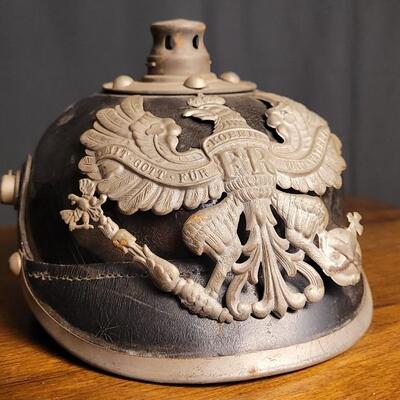
☆ Missing the top point. THE GERMAN ARMY’S spiked helmet or pickelhaube (is arguably one of the most enduring symbols of the First World War. The polished black leather helmet with ornamental metal spike on top did very little to protect the wearer from bullets or shell fragments, but it was instantly recognizable by friend and foe alike. And while the pickelhaube will forever be linked to the armies of Kaiser Wilhelm II, the distinctive piece of headgear was enormously popular with a number of nations’ armies during the 19th Century. 2021 / 2244 -
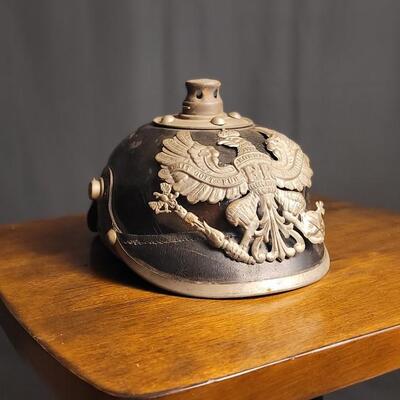
☆ Missing the top point. THE GERMAN ARMY’S spiked helmet or pickelhaube (is arguably one of the most enduring symbols of the First World War. The polished black leather helmet with ornamental metal spike on top did very little to protect the wearer from bullets or shell fragments, but it was instantly recognizable by friend and foe alike. And while the pickelhaube will forever be linked to the armies of Kaiser Wilhelm II, the distinctive piece of headgear was enormously popular with a number of nations’ armies during the 19th Century. 2022 / 2244 -
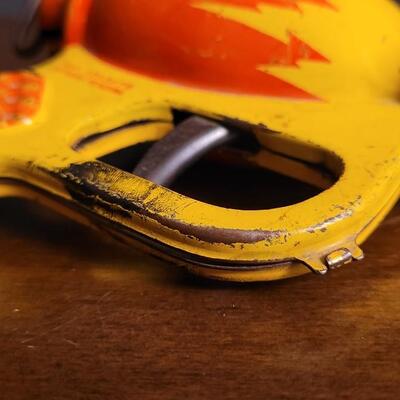
This is a Buck Roger Liquid Helium Toy Water Pistol manufactured by Daisy Manufacturing Co. in 1936. Inside the toy's metal body, where the red and yellow lightning bolts meet, a leather sack held the water for this water gun. The gun was also issued in a solid copper-colored finish, which has become the more rare of the two versions. Fictional space heroes often carried space-themed versions of the Western's ever-present six-shooter or rifle. As a result, for several generations, pretend gun play with ray gun toys formed a central part of many children's imagined space adventures. Exactly how one blasted space enemies often reflected the newest technologies. In the late 1940s, "atomic" guns proliferated. "Laser" guns followed the creation of the practical laser in 1960. 2023 / 2244 sold -
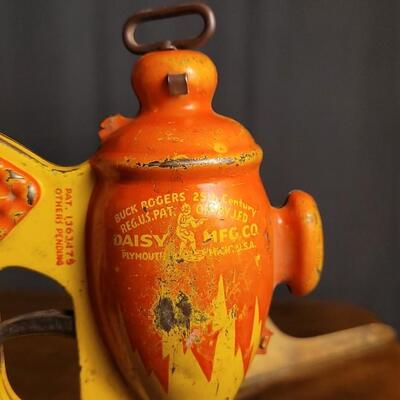
This is a Buck Roger Liquid Helium Toy Water Pistol manufactured by Daisy Manufacturing Co. in 1936. Inside the toy's metal body, where the red and yellow lightning bolts meet, a leather sack held the water for this water gun. The gun was also issued in a solid copper-colored finish, which has become the more rare of the two versions. Fictional space heroes often carried space-themed versions of the Western's ever-present six-shooter or rifle. As a result, for several generations, pretend gun play with ray gun toys formed a central part of many children's imagined space adventures. Exactly how one blasted space enemies often reflected the newest technologies. In the late 1940s, "atomic" guns proliferated. "Laser" guns followed the creation of the practical laser in 1960. 2024 / 2244 sold -
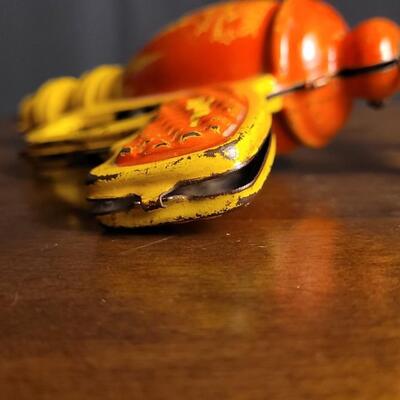
This is a Buck Roger Liquid Helium Toy Water Pistol manufactured by Daisy Manufacturing Co. in 1936. Inside the toy's metal body, where the red and yellow lightning bolts meet, a leather sack held the water for this water gun. The gun was also issued in a solid copper-colored finish, which has become the more rare of the two versions. Fictional space heroes often carried space-themed versions of the Western's ever-present six-shooter or rifle. As a result, for several generations, pretend gun play with ray gun toys formed a central part of many children's imagined space adventures. Exactly how one blasted space enemies often reflected the newest technologies. In the late 1940s, "atomic" guns proliferated. "Laser" guns followed the creation of the practical laser in 1960. 2025 / 2244 sold -
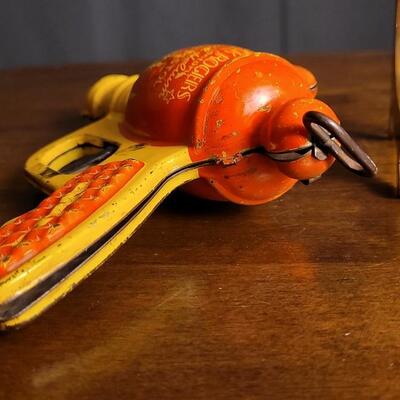
This is a Buck Roger Liquid Helium Toy Water Pistol manufactured by Daisy Manufacturing Co. in 1936. Inside the toy's metal body, where the red and yellow lightning bolts meet, a leather sack held the water for this water gun. The gun was also issued in a solid copper-colored finish, which has become the more rare of the two versions. Fictional space heroes often carried space-themed versions of the Western's ever-present six-shooter or rifle. As a result, for several generations, pretend gun play with ray gun toys formed a central part of many children's imagined space adventures. Exactly how one blasted space enemies often reflected the newest technologies. In the late 1940s, "atomic" guns proliferated. "Laser" guns followed the creation of the practical laser in 1960. 2026 / 2244 sold -
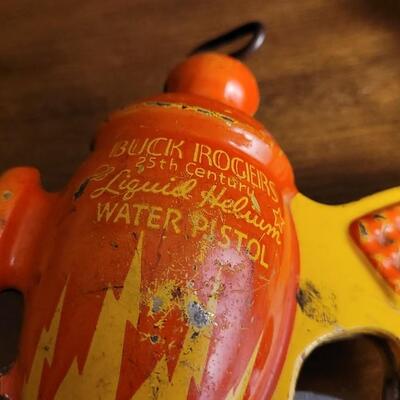
This is a Buck Roger Liquid Helium Toy Water Pistol manufactured by Daisy Manufacturing Co. in 1936. Inside the toy's metal body, where the red and yellow lightning bolts meet, a leather sack held the water for this water gun. The gun was also issued in a solid copper-colored finish, which has become the more rare of the two versions. Fictional space heroes often carried space-themed versions of the Western's ever-present six-shooter or rifle. As a result, for several generations, pretend gun play with ray gun toys formed a central part of many children's imagined space adventures. Exactly how one blasted space enemies often reflected the newest technologies. In the late 1940s, "atomic" guns proliferated. "Laser" guns followed the creation of the practical laser in 1960. 2027 / 2244 sold -
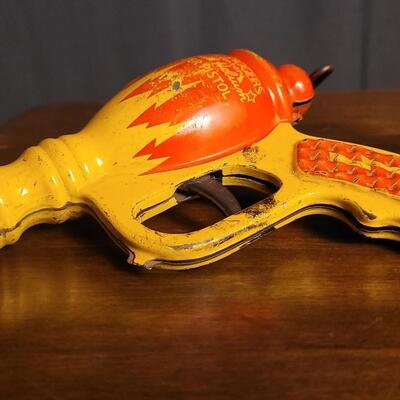
This is a Buck Roger Liquid Helium Toy Water Pistol manufactured by Daisy Manufacturing Co. in 1936. Inside the toy's metal body, where the red and yellow lightning bolts meet, a leather sack held the water for this water gun. The gun was also issued in a solid copper-colored finish, which has become the more rare of the two versions. Fictional space heroes often carried space-themed versions of the Western's ever-present six-shooter or rifle. As a result, for several generations, pretend gun play with ray gun toys formed a central part of many children's imagined space adventures. Exactly how one blasted space enemies often reflected the newest technologies. In the late 1940s, "atomic" guns proliferated. "Laser" guns followed the creation of the practical laser in 1960. 2028 / 2244 sold -
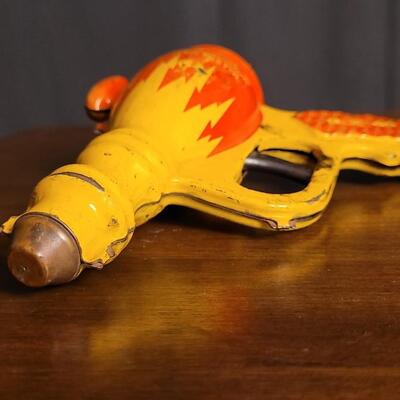
This is a Buck Roger Liquid Helium Toy Water Pistol manufactured by Daisy Manufacturing Co. in 1936. Inside the toy's metal body, where the red and yellow lightning bolts meet, a leather sack held the water for this water gun. The gun was also issued in a solid copper-colored finish, which has become the more rare of the two versions. Fictional space heroes often carried space-themed versions of the Western's ever-present six-shooter or rifle. As a result, for several generations, pretend gun play with ray gun toys formed a central part of many children's imagined space adventures. Exactly how one blasted space enemies often reflected the newest technologies. In the late 1940s, "atomic" guns proliferated. "Laser" guns followed the creation of the practical laser in 1960. 2029 / 2244 sold -
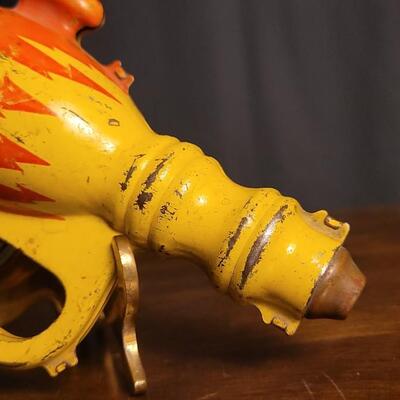
This is a Buck Roger Liquid Helium Toy Water Pistol manufactured by Daisy Manufacturing Co. in 1936. Inside the toy's metal body, where the red and yellow lightning bolts meet, a leather sack held the water for this water gun. The gun was also issued in a solid copper-colored finish, which has become the more rare of the two versions. Fictional space heroes often carried space-themed versions of the Western's ever-present six-shooter or rifle. As a result, for several generations, pretend gun play with ray gun toys formed a central part of many children's imagined space adventures. Exactly how one blasted space enemies often reflected the newest technologies. In the late 1940s, "atomic" guns proliferated. "Laser" guns followed the creation of the practical laser in 1960. 2030 / 2244 sold -
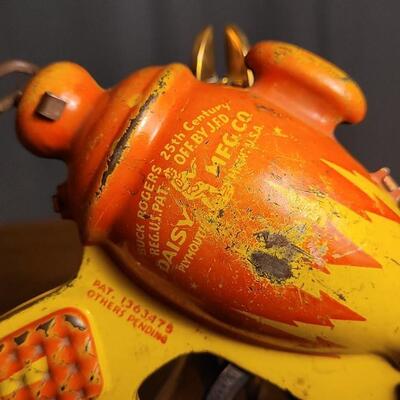
This is a Buck Roger Liquid Helium Toy Water Pistol manufactured by Daisy Manufacturing Co. in 1936. Inside the toy's metal body, where the red and yellow lightning bolts meet, a leather sack held the water for this water gun. The gun was also issued in a solid copper-colored finish, which has become the more rare of the two versions. Fictional space heroes often carried space-themed versions of the Western's ever-present six-shooter or rifle. As a result, for several generations, pretend gun play with ray gun toys formed a central part of many children's imagined space adventures. Exactly how one blasted space enemies often reflected the newest technologies. In the late 1940s, "atomic" guns proliferated. "Laser" guns followed the creation of the practical laser in 1960. 2031 / 2244 sold -
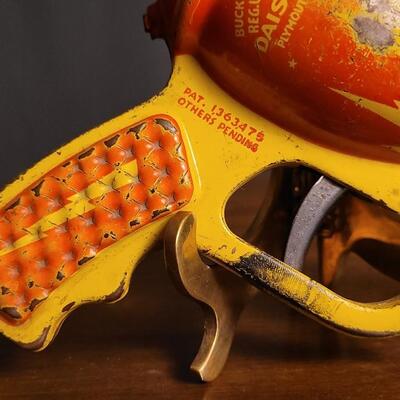
This is a Buck Roger Liquid Helium Toy Water Pistol manufactured by Daisy Manufacturing Co. in 1936. Inside the toy's metal body, where the red and yellow lightning bolts meet, a leather sack held the water for this water gun. The gun was also issued in a solid copper-colored finish, which has become the more rare of the two versions. Fictional space heroes often carried space-themed versions of the Western's ever-present six-shooter or rifle. As a result, for several generations, pretend gun play with ray gun toys formed a central part of many children's imagined space adventures. Exactly how one blasted space enemies often reflected the newest technologies. In the late 1940s, "atomic" guns proliferated. "Laser" guns followed the creation of the practical laser in 1960. 2032 / 2244 sold -
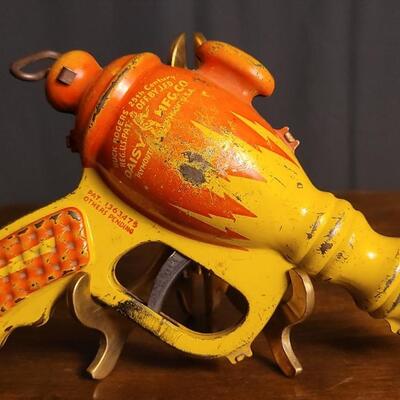
This is a Buck Roger Liquid Helium Toy Water Pistol manufactured by Daisy Manufacturing Co. in 1936. Inside the toy's metal body, where the red and yellow lightning bolts meet, a leather sack held the water for this water gun. The gun was also issued in a solid copper-colored finish, which has become the more rare of the two versions. Fictional space heroes often carried space-themed versions of the Western's ever-present six-shooter or rifle. As a result, for several generations, pretend gun play with ray gun toys formed a central part of many children's imagined space adventures. Exactly how one blasted space enemies often reflected the newest technologies. In the late 1940s, "atomic" guns proliferated. "Laser" guns followed the creation of the practical laser in 1960. 2033 / 2244 sold -
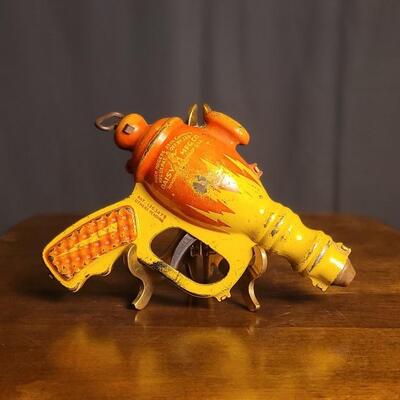
This is a Buck Roger Liquid Helium Toy Water Pistol manufactured by Daisy Manufacturing Co. in 1936. Inside the toy's metal body, where the red and yellow lightning bolts meet, a leather sack held the water for this water gun. The gun was also issued in a solid copper-colored finish, which has become the more rare of the two versions. Fictional space heroes often carried space-themed versions of the Western's ever-present six-shooter or rifle. As a result, for several generations, pretend gun play with ray gun toys formed a central part of many children's imagined space adventures. Exactly how one blasted space enemies often reflected the newest technologies. In the late 1940s, "atomic" guns proliferated. "Laser" guns followed the creation of the practical laser in 1960. 2034 / 2244 sold -
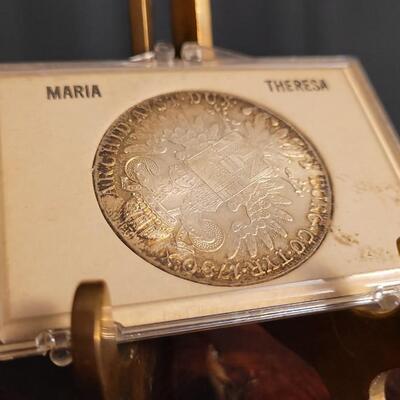
They have a silver purity of 83.3% and are alloyed with copper. The Maria Theresa thaler from Austria is one of the world's most well-known coins. These were originally issued starting in 1780. However, in certain parts of the world these coins were still circulating into the mid-1900s. The Maria Theresa thaler shown here is a restrike from the 19th century. The first restrikes were produced by the Austrian Mint in 1857. Classic Maria Theresa design The obverse features a classic portrait of Empress Maria Theresa. This portrait has been used for Maria Theresa thalers for hundreds of years. A Latin legend can be seen around the Empress. The date of 1780 is displayed on the reverse, but notice the "X" next to it. The detailed design on this side shows an eagle with two heads behind a shield. A number of crowns can be found throughout the design as well. Restrike in capsule This Maria Theresa thaler restrike has not been certified, but it is protected by a capsule. Capsules like this will preserve coins for many years and they are very good for keeping them safe during storage. 2035 / 2244 sold -
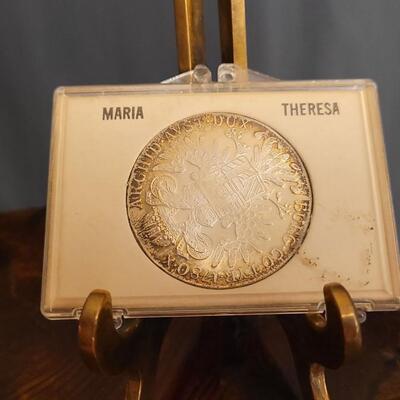
They have a silver purity of 83.3% and are alloyed with copper. The Maria Theresa thaler from Austria is one of the world's most well-known coins. These were originally issued starting in 1780. However, in certain parts of the world these coins were still circulating into the mid-1900s. The Maria Theresa thaler shown here is a restrike from the 19th century. The first restrikes were produced by the Austrian Mint in 1857. Classic Maria Theresa design The obverse features a classic portrait of Empress Maria Theresa. This portrait has been used for Maria Theresa thalers for hundreds of years. A Latin legend can be seen around the Empress. The date of 1780 is displayed on the reverse, but notice the "X" next to it. The detailed design on this side shows an eagle with two heads behind a shield. A number of crowns can be found throughout the design as well. Restrike in capsule This Maria Theresa thaler restrike has not been certified, but it is protected by a capsule. Capsules like this will preserve coins for many years and they are very good for keeping them safe during storage. 2036 / 2244 sold -
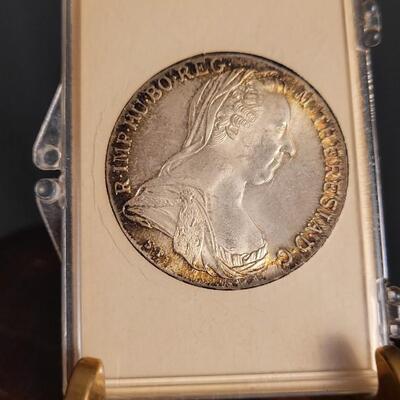
They have a silver purity of 83.3% and are alloyed with copper. The Maria Theresa thaler from Austria is one of the world's most well-known coins. These were originally issued starting in 1780. However, in certain parts of the world these coins were still circulating into the mid-1900s. The Maria Theresa thaler shown here is a restrike from the 19th century. The first restrikes were produced by the Austrian Mint in 1857. Classic Maria Theresa design The obverse features a classic portrait of Empress Maria Theresa. This portrait has been used for Maria Theresa thalers for hundreds of years. A Latin legend can be seen around the Empress. The date of 1780 is displayed on the reverse, but notice the "X" next to it. The detailed design on this side shows an eagle with two heads behind a shield. A number of crowns can be found throughout the design as well. Restrike in capsule This Maria Theresa thaler restrike has not been certified, but it is protected by a capsule. Capsules like this will preserve coins for many years and they are very good for keeping them safe during storage. 2037 / 2244 sold -
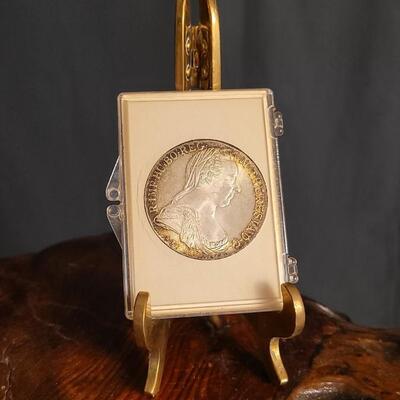
They have a silver purity of 83.3% and are alloyed with copper. The Maria Theresa thaler from Austria is one of the world's most well-known coins. These were originally issued starting in 1780. However, in certain parts of the world these coins were still circulating into the mid-1900s. The Maria Theresa thaler shown here is a restrike from the 19th century. The first restrikes were produced by the Austrian Mint in 1857. Classic Maria Theresa design The obverse features a classic portrait of Empress Maria Theresa. This portrait has been used for Maria Theresa thalers for hundreds of years. A Latin legend can be seen around the Empress. The date of 1780 is displayed on the reverse, but notice the "X" next to it. The detailed design on this side shows an eagle with two heads behind a shield. A number of crowns can be found throughout the design as well. Restrike in capsule This Maria Theresa thaler restrike has not been certified, but it is protected by a capsule. Capsules like this will preserve coins for many years and they are very good for keeping them safe during storage. 2038 / 2244 sold -
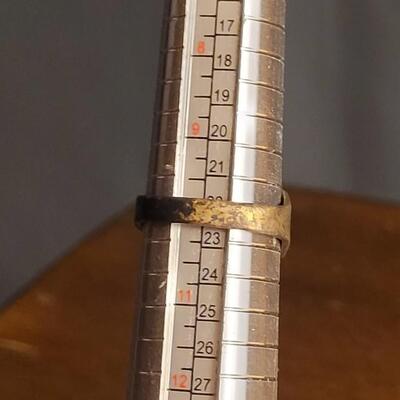
This lot features a handsome Antique Sterling Men's Signet ring in Size 10. The back stone does show some chip indicative and expected with age and general use. Apparent the owner proudly wore this artifact often and didn't dare remove it regardless of activity. Does show a bit of abnormal shape to the Circular ring shape but nothing serious (fits on finger fine). A fine addition to any jewelry collection. 2056 / 2244 -
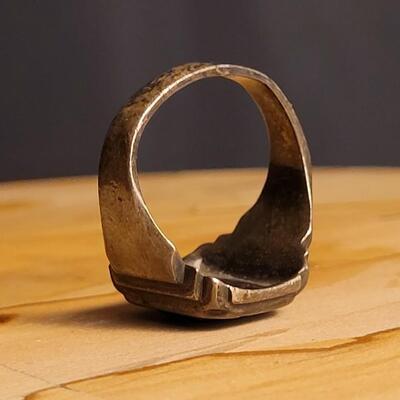
This lot features a handsome Antique Sterling Men's Signet ring in Size 10. The back stone does show some chip indicative and expected with age and general use. Apparent the owner proudly wore this artifact often and didn't dare remove it regardless of activity. Does show a bit of abnormal shape to the Circular ring shape but nothing serious (fits on finger fine). A fine addition to any jewelry collection. 2057 / 2244 -
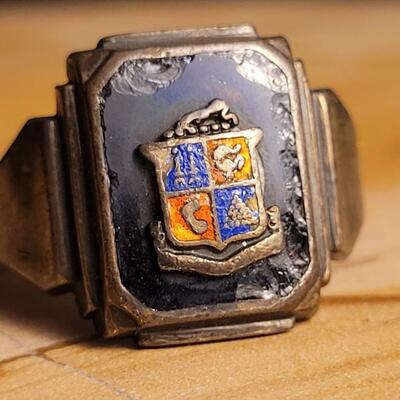
This lot features a handsome Antique Sterling Men's Signet ring in Size 10. The back stone does show some chip indicative and expected with age and general use. Apparent the owner proudly wore this artifact often and didn't dare remove it regardless of activity. Does show a bit of abnormal shape to the Circular ring shape but nothing serious (fits on finger fine). A fine addition to any jewelry collection. 2058 / 2244 -
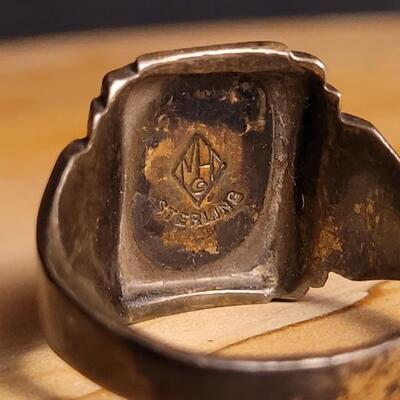
This lot features a handsome Antique Sterling Men's Signet ring in Size 10. The back stone does show some chip indicative and expected with age and general use. Apparent the owner proudly wore this artifact often and didn't dare remove it regardless of activity. Does show a bit of abnormal shape to the Circular ring shape but nothing serious (fits on finger fine). A fine addition to any jewelry collection. 2059 / 2244 -
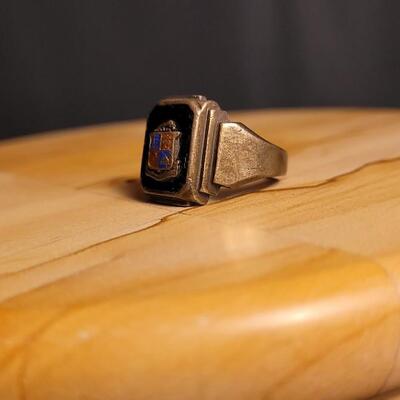
This lot features a handsome Antique Sterling Men's Signet ring in Size 10. The back stone does show some chip indicative and expected with age and general use. Apparent the owner proudly wore this artifact often and didn't dare remove it regardless of activity. Does show a bit of abnormal shape to the Circular ring shape but nothing serious (fits on finger fine). A fine addition to any jewelry collection. 2060 / 2244 -
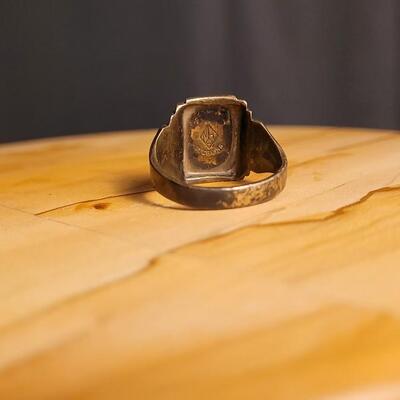
This lot features a handsome Antique Sterling Men's Signet ring in Size 10. The back stone does show some chip indicative and expected with age and general use. Apparent the owner proudly wore this artifact often and didn't dare remove it regardless of activity. Does show a bit of abnormal shape to the Circular ring shape but nothing serious (fits on finger fine). A fine addition to any jewelry collection. 2061 / 2244 -
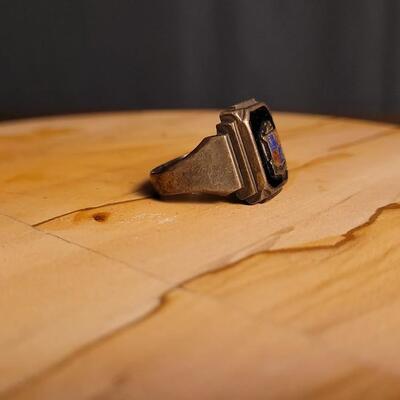
This lot features a handsome Antique Sterling Men's Signet ring in Size 10. The back stone does show some chip indicative and expected with age and general use. Apparent the owner proudly wore this artifact often and didn't dare remove it regardless of activity. Does show a bit of abnormal shape to the Circular ring shape but nothing serious (fits on finger fine). A fine addition to any jewelry collection. 2062 / 2244 -
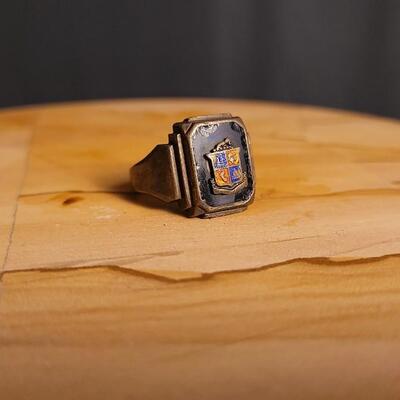
This lot features a handsome Antique Sterling Men's Signet ring in Size 10. The back stone does show some chip indicative and expected with age and general use. Apparent the owner proudly wore this artifact often and didn't dare remove it regardless of activity. Does show a bit of abnormal shape to the Circular ring shape but nothing serious (fits on finger fine). A fine addition to any jewelry collection. 2063 / 2244 -
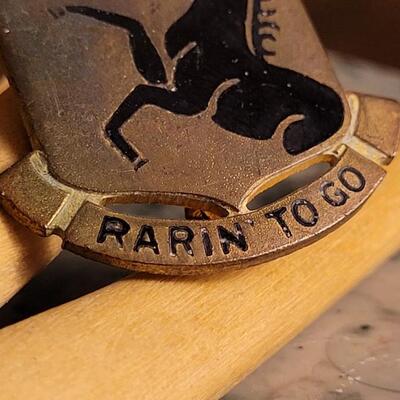
Appearing to be from the earlier parts of the regiment's formation, this pin showcases the unit crest of the 112th Cavalry Regiment and is worn on the Army Dress Blue (ASU) Uniform. The unit's motto, "Rarin' To Go," is displayed across the bottom of the design. The main image is a rearing black horse on a gold background, both symbolic of the unit's cavalry designation. The star and wreath at the top are the crest of the Texas Army National Guard, of which the 112th Cavalry Regiment is a part. 2064 / 2244 sold -
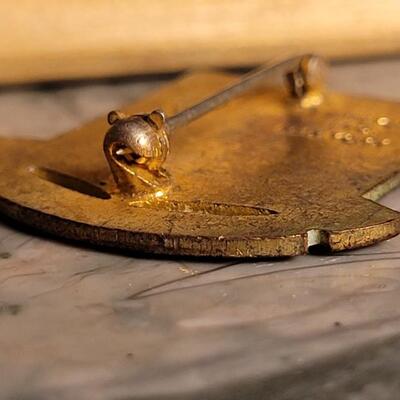
Appearing to be from the earlier parts of the regiment's formation, this pin showcases the unit crest of the 112th Cavalry Regiment and is worn on the Army Dress Blue (ASU) Uniform. The unit's motto, "Rarin' To Go," is displayed across the bottom of the design. The main image is a rearing black horse on a gold background, both symbolic of the unit's cavalry designation. The star and wreath at the top are the crest of the Texas Army National Guard, of which the 112th Cavalry Regiment is a part. 2065 / 2244 sold -
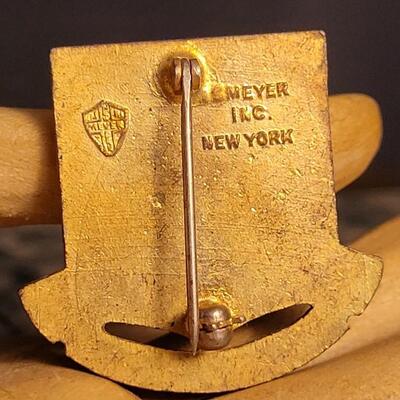
Appearing to be from the earlier parts of the regiment's formation, this pin showcases the unit crest of the 112th Cavalry Regiment and is worn on the Army Dress Blue (ASU) Uniform. The unit's motto, "Rarin' To Go," is displayed across the bottom of the design. The main image is a rearing black horse on a gold background, both symbolic of the unit's cavalry designation. The star and wreath at the top are the crest of the Texas Army National Guard, of which the 112th Cavalry Regiment is a part. 2066 / 2244 sold -
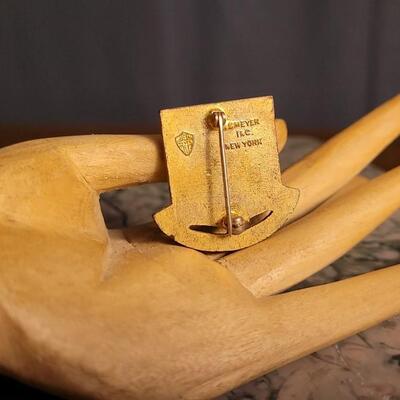
Appearing to be from the earlier parts of the regiment's formation, this pin showcases the unit crest of the 112th Cavalry Regiment and is worn on the Army Dress Blue (ASU) Uniform. The unit's motto, "Rarin' To Go," is displayed across the bottom of the design. The main image is a rearing black horse on a gold background, both symbolic of the unit's cavalry designation. The star and wreath at the top are the crest of the Texas Army National Guard, of which the 112th Cavalry Regiment is a part. 2067 / 2244 sold -
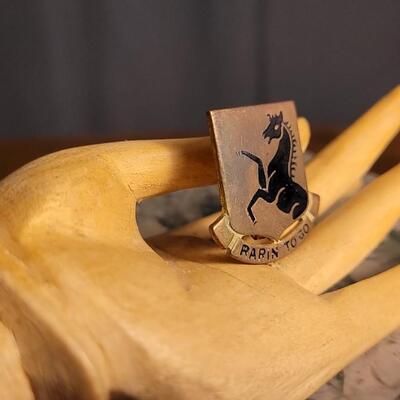
Appearing to be from the earlier parts of the regiment's formation, this pin showcases the unit crest of the 112th Cavalry Regiment and is worn on the Army Dress Blue (ASU) Uniform. The unit's motto, "Rarin' To Go," is displayed across the bottom of the design. The main image is a rearing black horse on a gold background, both symbolic of the unit's cavalry designation. The star and wreath at the top are the crest of the Texas Army National Guard, of which the 112th Cavalry Regiment is a part. 2068 / 2244 sold -
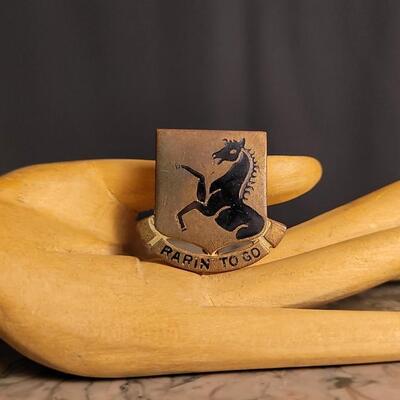
Appearing to be from the earlier parts of the regiment's formation, this pin showcases the unit crest of the 112th Cavalry Regiment and is worn on the Army Dress Blue (ASU) Uniform. The unit's motto, "Rarin' To Go," is displayed across the bottom of the design. The main image is a rearing black horse on a gold background, both symbolic of the unit's cavalry designation. The star and wreath at the top are the crest of the Texas Army National Guard, of which the 112th Cavalry Regiment is a part. 2069 / 2244 sold -
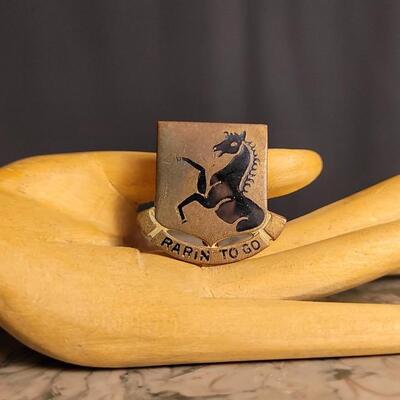
Appearing to be from the earlier parts of the regiment's formation, this pin showcases the unit crest of the 112th Cavalry Regiment and is worn on the Army Dress Blue (ASU) Uniform. The unit's motto, "Rarin' To Go," is displayed across the bottom of the design. The main image is a rearing black horse on a gold background, both symbolic of the unit's cavalry designation. The star and wreath at the top are the crest of the Texas Army National Guard, of which the 112th Cavalry Regiment is a part. 2070 / 2244 sold -
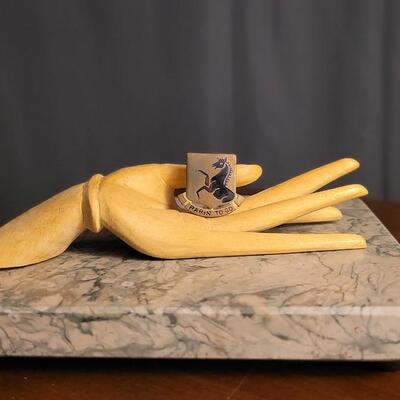
Appearing to be from the earlier parts of the regiment's formation, this pin showcases the unit crest of the 112th Cavalry Regiment and is worn on the Army Dress Blue (ASU) Uniform. The unit's motto, "Rarin' To Go," is displayed across the bottom of the design. The main image is a rearing black horse on a gold background, both symbolic of the unit's cavalry designation. The star and wreath at the top are the crest of the Texas Army National Guard, of which the 112th Cavalry Regiment is a part. 2071 / 2244 sold
Photos 2001 - 2100 of 2244
Per page:
